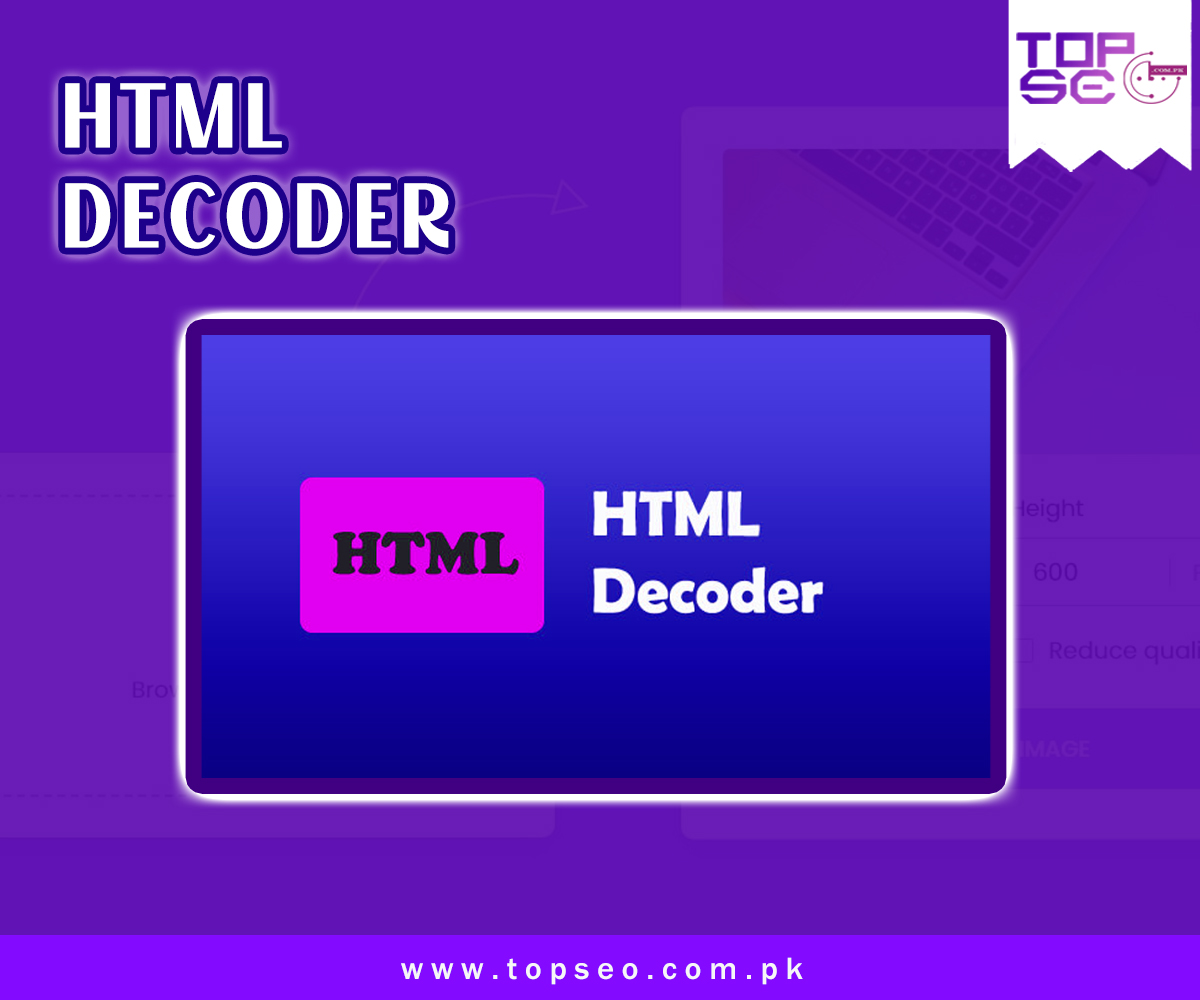




HTML Decoder
HTML - What do you mean by HTML?
HTML which is elaborated as HyperText Markup Langauge is the standard for the markup language of the web pages. This standard was set in the year 1981 by Berners-Lee. Almost every web page present on the internet is using the HyperText Markup Language.
A HyperText Markup Language (HTML) page describes the content of the page. In general, an HTML is a series of labels that indicate which text or element is included on the web page:
The HTML was originally developed to show the information in the form of texts and images. HTML is a language that is used to develop documents that are hypertext. Learning these documents is easy. Also, it allows anyone to design a site for those who don’t have any programming experience and basics.
HTML Decoding:
Converting a string that has been encoded in the HTML (HyperText Markup Language) for the transmission of HTTP into a decoded string. This process of conversion is known as HTML decoding.
Characters, Symbols, and Reserved Entities in the HTML:
The table down below shows a list of the reserved entities in the HTML with their associated description and characters.
| Character | Entity name | Description |
| " | " | quotation mark |
| ' | ' | apostrophe |
| & | & | ampersand |
| < | < | less-than |
| > | > | greater-than |
| | non-breaking space | |
| ¡ | ¡ | inverted exclamation mark |
| ¢ | ¢ | cent |
| £ | £ | pound |
| ¤ | ¤ | currency |
| ¥ | ¥ | yen |
| ¦ | ¦ | broken vertical bar |
| § | § | section |
| ¨ | ¨ | spacing diaeresis |
| © | © | copyright |
| ª | ª | feminine ordinal indicator |
| « | « | angle quotation mark (left) |
| ¬ | ¬ | negation |
| | ­ | soft hyphen |
| ® | ® | registered trademark |
| ¯ | ¯ | spacing macron |
| ° | ° | degree |
| ± | ± | plus-or-minus |
| ² | ² | superscript 2 |
| ³ | ³ | superscript 3 |
| ´ | ´ | spacing acute |
| µ | µ | micro |
| ¶ | ¶ | paragraph |
| · | · | middle dot |
| ¸ | ¸ | spacing cedilla |
| ¹ | ¹ | superscript 1 |
| º | º | masculine ordinal indicator |
| » | » | angle quotation mark (right) |
| ¼ | ¼ | fraction 1/4 |
| ½ | ½ | fraction 1/2 |
| ¾ | ¾ | fraction 3/4 |
| ¿ | ¿ | inverted question mark |
| × | × | multiplication |
| ÷ | ÷ | division |
| À | À | capital a, grave accent |
| Á | Á | capital a, acute accent |
| Â | Â | capital a, circumflex accent |
| Ã | Ã | capital a, tilde |
| Ä | Ä | capital a, umlaut mark |
| Å | Å | capital a, ring |
| Æ | Æ | capital ae |
| Ç | Ç | capital c, cedilla |
| È | È | capital e, grave accent |
| É | É | capital e, acute accent |
| Ê | Ê | capital e, circumflex accent |
| Ë | Ë | capital e, umlaut mark |
| Ì | Ì | capital i, grave accent |
| Í | Í | capital i, acute accent |
| Î | Î | capital i, circumflex accent |
| Ï | Ï | capital i, umlaut mark |
| Ð | Ð | capital eth, Icelandic |
| Ñ | Ñ | capital n, tilde |
| Ò | Ò | capital o, grave accent |
| Ó | Ó | capital o, acute accent |
| Ô | Ô | capital o, circumflex accent |
| Õ | Õ | capital o, tilde |
| Ö | Ö | capital o, umlaut mark |
| Ø | Ø | capital o, slash |
| Ù | Ù | capital u, grave accent |
| Ú | Ú | capital u, acute accent |
| Û | Û | capital u, circumflex accent |
| Ü | Ü | capital u, umlaut mark |
| Ý | Ý | capital y, acute accent |
| Þ | Þ | capital THORN, Icelandic |
| ß | ß | small sharp s, German |
| à | à | small a, grave accent |
| á | á | small a, acute accent |
| â | â | small a, circumflex accent |
| ã | ã | small a, tilde |
| ä | ä | small a, umlaut mark |
| å | å | small a, ring |
| æ | æ | small ae |
| ç | ç | small c, cedilla |
| è | è | small e, grave accent |
| é | é | small e, acute accent |
| ê | ê | small e, circumflex accent |
| ë | ë | small e, umlaut mark |
| ì | ì | small i, grave accent |
| í | í | small i, acute accent |
| î | î | small i, circumflex accent |
| ï | ï | small i, umlaut mark |
| ð | ð | small eth, Icelandic |
| ñ | ñ | small n, tilde |
| ò | ò | small o, grave accent |
| ó | ó | small o, acute accent |
| ô | ô | small o, circumflex accent |
| õ | õ | small o, tilde |
| ö | ö | small o, umlaut mark |
| ø | ø | small o, slash |
| ù | ù | small u, grave accent |
| ú | ú | small u, acute accent |
| û | û | small u, circumflex accent |
| ü | ü | small u, umlaut mark |
| ý | ý | small y, acute accent |
| þ | þ | small thorn, Icelandic |
| ÿ | ÿ | small y, umlaut mark |
Decoding of HTML - HTML Decoder by TopSEO:
HTML Decoder decodes all the encoded text into their HTML entities. Each character has a particular meaning. Every converted entity code delivers the original message of the character.
Using the HTML Decoder by TopSEO:
Using the HTML Decoder by TopSEO is very simple. The TopSEO’s developers have designed this tool to check the encoded strings in quick real-time. By using this tool you can encrypt all the characters which also includes the character supported by ASCII.
To decode an encoded HTML text by using an HTML Decoder by TopSEO follow the steps:
What you can do with TopSEO’s HTML Encoder?
HTML Decode tool is a unique decoding tool to decode the encoded HTML text.
Is there a need for HTML Decoding?
Then HTML decoding replaces the special characters in the HTML like <, > with the reserved entities of HTML which are recognized by the engine of the HTML. The most common case of using HTML encoding is when you want to show the special characters of HTML text in your HTML element content.
CONCLUSION:
HTML, HyperText Markup Language defines the content of the web page. HTML decoder decodes all the HTML which is encoded into the HTML entities. HTML Decoder is a tool by TopSEO which is easy to decode the plain HTML into encoded HTML. This helps you to show the HTML text in the HTML <pre> tags.







